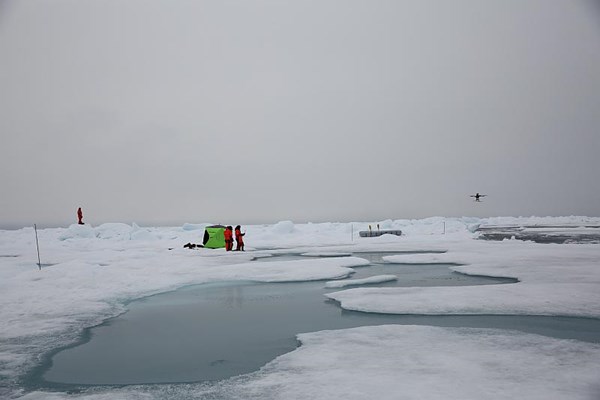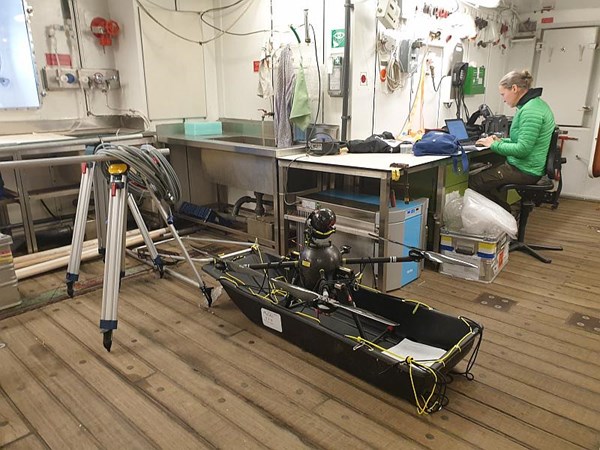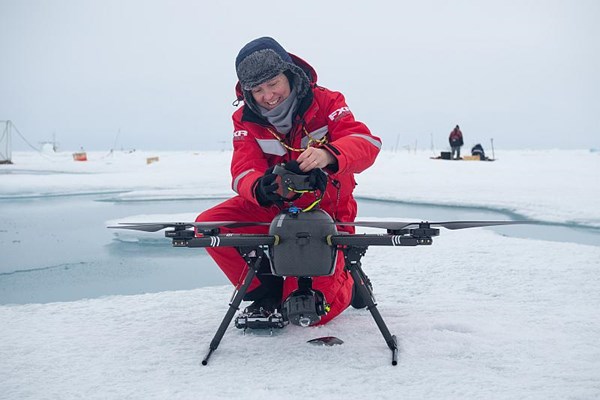
Henna and Roberta, MOSAiC Leg 5. Photo: Lianna Nixon.
The coronavirus did not stop MOSAiC (Multidisciplinary Drifting Observatory of the Study of Arctic Climate) Expedition, the largest polar expedition in history. The last phase of the expedition, “leg 5”, took place from 3rd of August to 12th October 2020, and was preceded by two weeks of quarantine in Bremerhaven. The goal of the year-around MOSAiC expedition is to investigate the processes occurring in the various components of the Arctic Climate System (atmosphere, sea ice, ocean, biogeochemistry and ecosystem) and the interactions between them.
Roberta Pirazzini and Henna-Reetta Hannula from the Finnish Meteorological Institute participated in this final MOSAiC phase through the project “DEvelopment of snow/ice/ecosystem models using winter-to-summer ARctic observations of coupled snow, ice, and ecosystem processes” (DEARice) funded by the EU H2020 project ARICE, with the contribution of INTAROS in the development of the drone SPECTRA to be used in ships of opportunity.
 Big drone flying over the ice floe, piloted by Roberta. Photo: Folke Mehrtens.
Big drone flying over the ice floe, piloted by Roberta. Photo: Folke Mehrtens.
Spectral and broadband radiometers were installed on the drone to measure the surface albedo over different horizontal scales. These measurements enable the derivation of relationships between the albedo measured from ground-based platforms, which typically have metre-to-tens-of-meters footprint, and satellite observations or large-grid model outputs. Roberta and Henna also participated in the other ICE team measurement activities, especially contributing to the snow measurements and to the characterization of the ice surface scattering layer.
Leg 5 was special, in a way a mini complete MOSAiC: at the end of Leg 4 the original MOSAiC ice floe had broken apart, therefore Leg 5 included the search of a new ice floe, the camp installation, the establishment of the daily routines, the camp removal, and the packing of the entire cargo while returning to Bremerhaven. The new floe was found after crossing the North Pole and luckily did not break during the measurement period. The initial freezing state with already frozen melt ponds was followed by melting and re-opening of the melt ponds, and by a successive freeze-up and snow deposition over the melt ponds and leads. This surface evolution was associated to dramatic changes in surface albedo, which were captured by the SPECTRA aerial albedo measurements.

Roberta working in wet lab aboard Polarstern. Photo: Henna-Reetta Hannula.
Operating drones close to the North Pole was extremely challenging: the moist and freezing air conditions often prevented the flights, as ice quickly formed on the propellers. Moreover, the proximity with the geographical North Pole made the navigation system very unreliable and unstable, therefore take-off, landing, and part of the flights were carried out in manual mode. This required the selection of an isolated area for the drone operations to avoid collisions with people and other instruments. Furthermore, because of the drift of the ice floe during the flights, continuous adjustments of the drone position were needed, and when the wind chill temperatures dropped below -10°C it became difficult to keep the fingers warm and able to operate the sticks of the radio-controller for 20 consecutive minutes. Finally, the solar elevation and, thus, the incoming solar irradiance decreased throughout the observing period, making albedo measurements meaningful only for the 3 weeks of the observing period. Despite all these challenges, the pilots Roberta and Henna succeeded in performing 17 flights (corresponding to ~5 flight hours) with the SPECTRA drone, and 35 flights (corresponding to ~11.5 flight hours) with the smaller drone Mavic 2 Pro equipped with a camera to map the surface topography. The data will be stored at the PANGAEA data repository and made publicly accessible following the MOSAiC data policy.

Roberta with SPECTRA drone. Photo: Jan Rohde.
Submitted by: Roberta Pirazzini, FMI.
02 December 2020